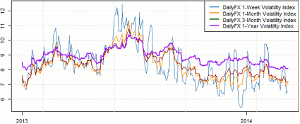Changing market conditions can create a frustrating trading environment for those unprepared, says Jeremy Wagner of DailyFX Education, so he shares three common mistakes as well as tips for avoiding them.
FX volatility has been down recently and is challenging multi-year lows (see chart below). We’ve seen some traders get frustrated with the low-volatility environment as they seek out trends or breakouts.

DailyFX Volatility Indices Chart
Click to Enlarge
However, low volatility conditions can benefit traders. According to our traits of successful traders research, FX traders are more profitable during low volatile times of day. This is because levels of support and resistance are more likely to hold, making a buy-low and sell-high strategy the preferred strategy.
Extrapolating this logic forward, this suggests that traders should also enjoy low volatile market conditions. If you find your trading has been inconsistent lately, here are three common mistakes traders make in trendless markets and how you can overcome these mistakes.
Inconsistent trading due to range bound markets could be a result of several factors. Here are three common mistakes made:
- Trend following strategy used in a trendless market
- Stop loss is too close
- Emotionally impatient with trades
Error #1: Using the wrong type of strategy
Correction: Match the strategy to the current market condition
One of the most overlooked elements in creating a trading plan is matching your strategy to the current market environment. Once we find a strategy that works, we tend to stick with that strategy. There is nothing wrong with that. However, we need to realize and remember that our strategy is NOT designed to do well all of the time. There are times when our strategy will be out of favor with the market conditions. It is recognizing those situations and then taking appropriate action that is the behavior we typically miss.
We do those things, which we are comfortable with. It is uncomfortable to change our strategy around or to trade a different instrument. However, if the market changes tune, so do we. We need methods in place to identify when the current strategy isn’t cut out for the current market environment.
Traders will use volatility (as seen in the image above), Average True Range (ATR), or Average Directional Index (ADX) as tools to identify when volatility is down.
The key point to remember is that when you see a different market today, change your strategy to meet that condition or change your currency pair to trade.
NEXT PAGE: 2 More Common Mistakes to Avoid
|pagebreak|Error #2: Stop loss is too close
Correction: Give your trade room to breathe for the life of the trade
Another common mistake that traders make is assuming their risk is relegated to the distance of their stop loss to their entry. The truth is the risk to your account is how much currency you stand to lose if the trade does not work out!
For example, I can have a stop loss 100 pips away and risk less than somebody else with a 10 pip stop loss. If my trade size is 100k, and if my stop loss is 100 pips, I would be risking $1,000 on the trade.
Assume somebody else has a trade size of 1500k; they have risked $1,500 on the trade with a 10 pip stop loss. Clearly, my trade of $1,000 risk is less than the other trade of $1,500 risk.
It is worth repeating again. The risk to your account is how much currency you stand to lose if wrong and not the distance to your stop loss.
If you find that you internally talk to yourself and use phrases like “I can’t risk 50 pips” or “100 pips is too much to risk” then remember you CAN place the trade if your reduce the trade size to LOWER the risk on the trade.
Tightening the stop loss too close is an invitation to get stopped out. In the example above, not only are they risking more, but they are inviting the market to stop them out of the trade with a stop loss too tight.
Use the ATR indicator to give an indication of how much the market has moved over the last several days. If it might take a couple of days to reach your profit target, then make sure the stop loss is wide enough to withstand the normal “breathing” of the market.
Error #3: Getting impatient and closing trades before the stop or target is reached
Correction: Remember that trendless markets generally take longer to reach support or resistance levels
Frustration for lack of movement is a big reason traders get impatient. We live in a culture of fast food and 15-minute oil changes. We want it and we want it now! The same applies in trading.
There have been some monster trends taking place over the past year. If you have successfully traded those trends, the physiological response you’ve experienced likely has you thirsty to do it again.
Since the last monster trade you had occurred over short time line, we begin to expect all trades to resolve within a short time line.
However, there are times when the market is comfortable trading where it is at. There are not any new pieces of data or shocks to the market causing severe price dislocations. Therefore, the market bounces between high and low points creating the trading range.
One way to keep from getting impatient is to follow what was stated in #2 above…trade with smaller trade sizes and think of your next trade as the first of ten trade sequence. By doing so, you will be placing less emphasis on the outcome of the trade allowing you to relax and let the trade resolve itself by hitting your profit target or stop loss level. Trading in smaller sizes is a simple way to allow your mind to relax so you can be patient on the trade.
By Jeremy Wagner, Head Trading Instructor, DailyFX Education










